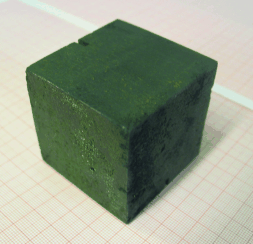Forensic investigation of uranium from German nuclear projects from the 1940s

In Germany in the 1940s, a variety of projects was launched to develop technical applications for the nuclear fission of uranium. Historical uranium samples from Germany have now undergone forensic investigation by an international team of researchers. As reported in the journal Angewandte Chemie, they were able to confirm the authenticity of the samples and to show that no self-sustained nuclear chain reaction was achieved in experiments of the time.
When neutrons strike uranium-235 nuclei, the nuclei absorb the neutrons to form unstable uranium-236, which falls apart into two pieces that fly apart at high velocity. This splitting reaction also forms two to three new neutrons, which can cause a chain reaction to begin. To do this, it is important that the neutrons are slowed down because the fast neutrons can barely be "trapped" by the uranium-235 nuclei. In a nuclear power plant, the chain reaction must be precisely controlled to ensure that only one of the neutrons produced will be available for inducing a further fission reaction, thereby resulting in a steady release of energy.
The first self-sustained chain reaction was achieved by Enrico Fermi in Chicago in 1942. "Whether the German nuclear projects had a military dimension or were rather aimed at the construction of an atomic reactor for energy production—or both—has previously been discussed," states Maria Wallenius, the European Commission's in-house science service, the Joint Research Centre, Institute for Transuranium Elements (ITU) in Karlsruhe. At the Kaiser Wilhelm Institute for Physics in Berlin, Werner Heisenberg experimented with uranium plates, whereas Kurt Diebner was working with uranium cubes at the German Army Ordnance Office. Heisenberg later acknowledged the superiority of the cube design. The last experiment, titled B8, took place in March 1945, after part of the Kaiser Wilhelm Institute had moved to Haigerloch. The fuel was 1.5 tons of natural uranium in the form of 664 "Heisenberg cubes". Wallenius explains the historical context: "A self-sustaining nuclear chain reaction was supposed to be initiated by neutron bombardment, but the attempt was unsuccessful because the reactor was too small."
In a nuclear forensic study, a team of scientists from ITU, the University of Mainz, the Australian National University (Canberra), and the University of Vienna investigated three historic samples of uranium: a powdered sample from a Heisenberg cube provided by the German Federal Office for Radiation Protection, a small piece of metal from a Heisenberg cube from the "Atomkeller Museum" in Haigerloch, and several small pieces of the "Wirtz plate", which is attributed to earlier experiments by the group working with Heisenberg and Wirtz. The team compared their results with those of uranium raw materials, which were partly produced in the 1940's or before.
The team determined ratios of various isotopes, such as that of uranium-234 to its decay product thorium-230, in order to determine when the material was produced. According to Wallenius, "this occurred indeed during the period 1940 for the Wirtz plate and 1943/44 for the cubes which is also a rock-solid proof of the authenticity of the samples." The researchers were also able to determine the geographical origins of the samples based on the rare-earth-element content and the ratio of strontium-87 to strontium-86 because these values are characteristic of different uranium deposit types. "Our results indicate that the uranium used for the plate and the cubes was mined in the Jachymov region (Czech Republic)," says Wallenius.
The samples also show minute amounts of uranium-236 and plutonium-239, corresponding to their natural occurrence. "This suggests that the uranium samples have not been exposed to a significant neutron fluence" says Wallenius. "The experimental results support historical reports that the German experiments did not result in a self-sustaining nuclear chain reaction."
More information: "Uranium from German Nuclear Power Projects of the 1940s— A Nuclear Forensic Investigation." Angew. Chem. Int. Ed.. doi: 10.1002/anie.201504874
Journal information: Angewandte Chemie , Angewandte Chemie International Edition
Provided by Wiley



















